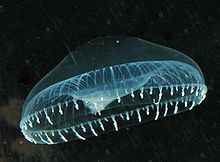Aequorea victoria
| Aequorea victoria | |
|---|---|
 |
|
| Scientific classification | |
| Kingdom: | Animalia |
| Phylum: | Cnidaria |
| Class: | Hydrozoa |
| Order: | Leptomedusae |
| Family: | Aequoreidae |
| Genus: | Aequorea |
| Species: | A. victoria |
| Binomial name | |
|
Aequorea victoria (Murbach and Shearer, 1902) |
|
Aequorea victoria, also sometimes called the crystal jelly, is a bioluminescent hydrozoan jellyfish, or hydromedusa, that is found off the west coast of North America.
The species is best known as the source of two proteins involved in bioluminescence, aequorin, a photoprotein, and green fluorescent protein (GFP). Their discoverers, Osamu Shimomura and colleagues, won the 2008 Nobel Prize in Chemistry for their work on GFP.
Almost entirely transparent and colorless, and sometimes difficult to resolve, Aequorea victoria possess a highly contractile mouth and manubrium at the center of up to 100 radial canals that extend to the bell margin. The bell margin is surrounded by uneven tentacles, up to 150 of them in fully-grown specimens. The tentacles possess that aid in prey capture, although they have no effect on humans. Specimens larger than 3 cm usually possess gonads for sexual reproduction, which run most of the length of the radial canals and are visible in the photos in this article as whitish thickenings along the radial canals. The bell margin is ringed with the muscular velum, which is typical of hydromedusae, and aids in locomotion through muscular contraction of the bell. Larger specimens are frequently found with symbiotic hyperiid amphipods attached to the subumbrella, or even occasionally living inside the gut or radial canals.
Aequorea victoria are found along the North American west coast of the Pacific Ocean from the Bering Sea to southern California. The medusa part of the life cycle is a pelagic organism, which is budded off a bottom-living polyp in late spring. The medusae can be found floating and swimming both nearshore and offshore in the eastern Pacific Ocean; this species is particularly common in Puget Sound.
In September 2009, Aequorea victoria was spotted in the Moray Firth, an unusual occurrence, as crystal jellies had never been seen or reported in British waters. The specimen was put on display in Macduff Marine Aquarium in Aberdeenshire, Scotland.
Aequorea species can be fairly difficult to tell apart, as the morphological features on which identifications are made are mostly the numbers of tentacles, numbers of radial canals, numbers of marginal statocysts, and size. These features are fairly plastic, and the numbers of tentacles and radial canals increase in all species of Aequorea with size. One other species is occasionally found in the same geographical range as Aequorea victoria; this other form has been called Aequorea coerulescens. While A. coerulescens is apparently generally found offshore in the eastern Pacific Ocean, rare specimens have been collected in central California and in Friday Harbor, North Puget Sound. While morphologically similar to Aequorea victoria, the Aequorea coerulescens form is larger (roughly the size of a dinner plate) with many more radial canals. Animals of sizes intermediate between these two forms are also rather intermediate in appearance, making morphological identifications difficult.
...
Wikipedia
